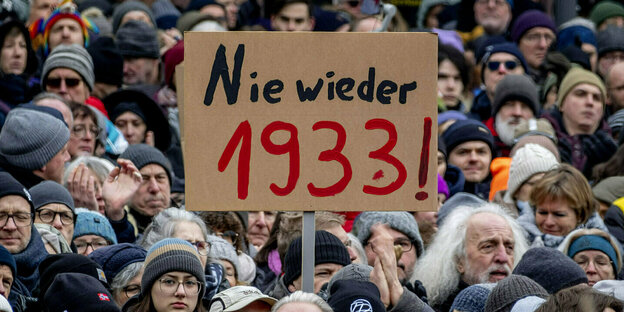During demonstrations against the right, people repeatedly make historical comparisons. Although they may seem obvious at first, they contain dangers.

We are currently not “close to 1933”, the year of the transfer of power, the founding of the Dachau concentration camp and the introduction of the “Aryan certificate”. Photo: Michael probst/ap
“Voting for the AfD is totally 1933,” says one sign. “So that the 1920s are not followed by 1933,” in another. And again and again the motto: “Now is never again.” A key mobilizing driver of the current protests against the social shift to the right and the rise of the AfD are references to the darkest chapters of German history. Because, according to a totally plausible idea: if a far-right party returns to power in this country, then hatred and agitation will become repressive policies against minorities and those who think differently. One more time. This concern, completely justified, is currently bringing hundreds of thousands of people to the streets.
The state elections in Saxony, Thuringia and Brandenburg, as well as the local elections in Mecklenburg-Vorpommern, portend bad things to come. AfD politicians fight for a strong, ethnic Germany. And this fantasy includes exclusion and expulsion.
So is history repeating itself at this point? No. Rather, historical comparisons – if they are biased, if there is a lack of knowledge of history, or if they are taken out of context – contain dangers.
Even the revelation of the research center. Corrective about a far-right “secret meeting” in Potsdam in November, which triggered the current mass protests, sparked associations with the Wannsee Conference, which took place “almost eight kilometers from the hotel,” as the article says. The meeting at which AfDers, Identitarians and members of the Union of Values dreamed of a “master plan for Germany” that included fantasies of “remigration” has since repeatedly been called the “Wannsee Conference 2.0.” Corrective writes that the idea of the identitarian Martin Sellner is reminiscent of the deportation plans of the National Socialists.
Decontextualizing the “never again is now”
But in Wannsee the expulsion and expatriation were not planned at that time, but had already been underway for a long time. Under the presidency of SS Obergruppenführer Reinhard Heydrich, high-ranking National Socialists met to better organize the extermination of European Jews. Adolf Eichmann took minutes. The deportations were a means to end systematic mass murder. The Wannsee meeting in the winter of 1942 he Eliminationist conference on antisemitism. The comparison is especially flawed if the current rampant anti-Semitism is not put into perspective.
The fact that National Socialism is not history, but can definitely return, is not a new idea. Already in the 1950s, Theodor W. Adorno questioned whether we had really overcome National Socialism. However, we are currently not “close to 1933”, the year of the transfer of power, the banning of trade unions, the burning of books, the founding of the Dachau concentration camp and the introduction of the “Aryan certificate”.
Starting in 1933, Jews could no longer work as civil servants or public employees. Within a few weeks, the opposition was eliminated, minorities were harassed, and the German people swore to join the National Socialist project. We won't get that far in 2024. And yet, that's no reason to give the go-ahead.
The decontextualization of “Never again is now” in the current anti-right demonstrations carries the risk that the criticism of anti-Semitism in the sentence is no longer seen. The slogan was not introduced as a response to the rightward shift in Germany, although it now seems to fit perfectly. It was created in response to Hamas' genocidal violence in Israel on October 7. In Germany, as in many other countries, this violence was followed by a wave of anti-Semitism that continues to this day.
Right-wing extremists are racist and also anti-Semitic
At the memorial hour for the victims of National Socialism in the German Bundestag on January 31, Shoah survivor Eva Szepesi ended her speech with the words “It is never again now.” Her speech shows exactly the connection that is being lost in the current large-scale demonstrations. Szepesi spoke of her stay in Budapest, her arrest and deportation, her selection in Auschwitz-Birkenau, the murder of her mother and, finally, her liberation and her life. after her. She then fast forwarded to the present, to October 7, 2023, the day “that changed everything for us Jews in the world.”
Regarding the more than 130 hostages still in the hands of the terrorist organization Hamas, he demanded: “Bring them home, now!” This is the situation to which the phrase “Never again is now” responds, the deadliest day for Jews since the Shoah.
Of course, Szepesi also spoke afterwards about Germany and how a far-right party should never again be so strong as to endanger democracy. He warned: “We are close to it.” However, his speech explicitly showed the connection between the Shoah of October 7 and the danger posed by German right-wing extremism.
If “Never again is now” does not want to be an empty phrase, it requires solidarity with the Jews. This is not always present in massive demonstrations against the right. Some enemies of Israel participated in these demonstrations and behaved aggressively towards hostesses and other participants in the demonstrations. A fatal sign for the Jews.
Right-wing extremists are racist and anti-Semitic. If you want to combat them in a sustainable way, you have to confront both phenomena. To help shape the present, we have to deal with the past. No historical superlatives. And with more solidarity towards the Jews.